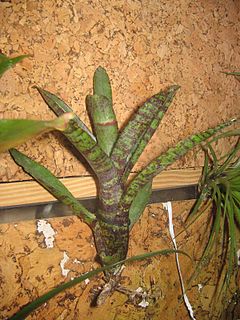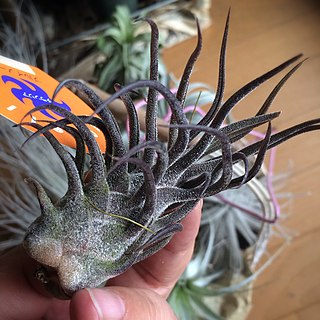Fosterella pearcei is a species of flowering plant in the Bromeliaceae family. It is endemic to Bolivia.

Puya sanctae-crucis is a species of flowering plant in the Bromeliaceae family. It is endemic to Bolivia.

Aechmea ornata is a species of flowering plant in the Bromeliaceae family. It is endemic to southern Brazil from Rio de Janeiro State south to Santa Catarina.

Aechmea sphaerocephala is a species of flowering plant in the Bromeliaceae family. It is endemic to southeastern Brazil, known from the States of Espírito Santo and Rio de Janeiro.
Billbergia tweedieana is a species of flowering plant in the Bromeliaceae family. This species is endemic to southeastern Brazil.
Neoregelia fosteriana is a species in the genus Neoregelia. This species is endemic to Brazil.

Neoregelia johannis is a species in the genus Neoregelia. This species is endemic to Brazil.
Neoregelia leucophoea is a species of flowering plant in the Bromeliaceae family. It is endemic to Brazil.
Neoregelia marmorata is a species flowering plant in the Bromeliaceae family. It is endemic to Brazil.

Neoregelia pauciflora is a species in the genus Neoregelia. This species is endemic to Brazil. The specific epithet pauciflora is Latin for 'few-flowered'.

Neoregelia spectabilis is a species of flowering plant in the family Bromeliaceae, native to the South Brazilian rainforest. Growing to 40 cm (16 in) tall by 80 cm (31 in) wide, it produces rosettes of up to 30 red-tipped strap-shaped leaves, the inner leaves coloured red; and, in summer, blue flowers with red or purple bracts.
Vriesea heterostachys is a species of flowering plant in the Bromeliaceae family. The bromeliad is endemic to the Atlantic Forest biome, located in southeastern Brazil.
Vriesea lancifolia is a species of flowering plant in the Bromeliaceae family.It is endemic to Brazil.
Vriesea lubbersii is a species of flowering plant in Bromeliaceae family. It is endemic to Brazil.
Vriesea poenulata is a species of flowering plant in the Bromeliaceae family. It is endemic to Brazil.

Aechmea miniata is a species of flowering plant in the Bromeliaceae family. This species is native to the state of Bahia in eastern Brazil.

Dyckia microcalyx is a species of flowering plant in the Bromeliaceae family. This species is native to Argentina, Paraguay and Brazil.

Tillandsia pruinosa, is a species of flowering plant in the Bromeliaceae family. It is commonly known as the fuzzywuzzy airplant. This species is native to northern South America, Central America, southern Mexico, the West Indies and Florida.
Fosterella schidosperma is a species of flowering plant in Bromeliaceae family. It is native to Peru and Bolivia.
Vriesea elata is a species of flowering plant in the Bromeliaceae family. It is an epiphyte native to Venezuela, Colombia, and Ecuador.









